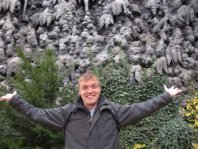Ferroelectrics from the bottom up
Investigation of nanoscale boundary conditions in ferroelectric thin films using novel bottom-up growth techniques
Promotion date: September 4.
Promotor: Prof. dr. ing. Guus Rijnders
Assistant Promotor: Dr.ir. Gertjan Koster
Prof.dr. André ten Elshof
| Ferroelectrics are an important class of materials due to their wide range of attractive properties. However, these properties are known to degrade as the size of the material enters the nanoscale.
In this thesis size effects of ferroelectrics are explored in a novel way, by modulating the boundary conditions under which the ferroelectric is subjected on the nanoscale. This is accomplished by engineering the bottom interface of the ferroelectric film which has the benefit of eliminating post processing of the ferroelectric,; removing extrinsic effects from the investigation of the ferroelectric properties. By using self-assembly techniques, to engineer the bottom interface, the entire sample is grown in a single deposition run, creating high quality structures which can be analyzed in situ, thus further reducing extrinsic effects due to contamination. Two self-assembly techniques were used to pattern the bottom interface: growth on nanowires and nanosheets. First the domain structure of 25nm PbTiO3 and BiFeO3 thin films on SrRuO3 nanowires was investigated, showing that the alignment of the domains with the nanowires is dependent of the growth mode of the ferroelectric during Pulsed Laser Deposition. Again using SrRuO3 nanowires, now as bottom electrodes, conductivity of domain walls in BiFeO3 was measured as a function of domain wall length, showing that the domain wall conductivity is bulk limited. Finally, Ca2Nb3O10 nanosheets were used as a seed layer for the investigation of size effects in PbTiO3 thin films. The nanosheets are one unit cell thick and range in size from 100 nm to 1.5 µm, allowing a wide range of lateral sizes to be studied in a single sample. Unlike the domain structure of a complete film the PbTiO3 on the nanosheets consisted of small circular domains with no observed change in the domain pattern or domain size with the size of the nanosheets. Furthermore, no increase of the piezoresponse was observed with decreasing size as is often reported in literature. |
Can you recall some special moments during your PhD period?
New types of domain patterns were created for the first time. The growth on nanowires was successful right from the start. At first try we already achieved some good results, much to my surprise. I anticipated on having several tries over and over again, before being able to show any clear results. So, the PhD project started with some nice and quick results. Apart from me, my colleagues were surprised as well.
A second result which I cherish was getting to have my samples characterized using Transmission Electron Microscopy and being able to see “inside” my films in atomic precision. Here the collaboration with colleagues from the University of Antwerp was decisive, to characterize the results.
The findings of my PhD work were fundamental in nature. Useful knowledge was generated, beneficial for building applications in which ferromagnetic materials are used in the longer run.
What are your future plans?
I am leaning towards an academic career in the future as I like the research environment here, being able to choose my own path and topics of interest. In industry one is much more limited in exploring fundamental aspects. I am challenged by these a lot, as I am very curious to find out the truth about how things actually behave.
Right now I am working at the Max Planck Institute for Solid State Physics in Stuttgart (Germany) at the Solid State Quantum Electronics Group. The topic of research is a continuation of my work at Mesa+, with quite some new aspects.
What in your opinion is needed for Mesa+ to stay successful in future?
Working at Mesa+ opened up some great collaboration opportunities for me during my PhD period. Apart from collaboration with the colleagues from Antwerp, I performed an interesting research project in the United Stated, at the Oak Ridge National Lab, specialized as they are in advanced AFM studies. This was very helpful in my project. I was able to combine this expertise with advanced techniques in-house at Mesa+. Here we had access to very accurate lithographic techniques, making Mesa+ an interesting partner. I am convinced the access to state of the art facilities and (shared) equipment makes all the difference in international nano-technological research nowadays.

